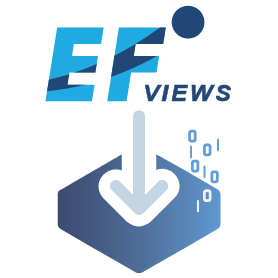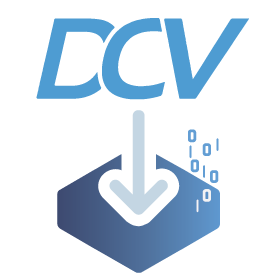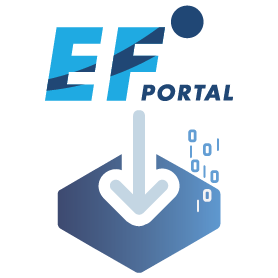
EF Portal 2025.1 is released: powerful monitoring, smarter admin tools, and a REST API boost!
We’re excited to announce the release of EF Portal 2025.1, now available for deployment.
This release continues to build on our goal of making EF Portal the most powerful and flexible gateway for HPC and remote desktop environments. Whether you’re an admin or a user, 2025.1 brings new ways to monitor, automate, and secure your platform, while boosting performance under the hood.
What’s new in a nutshell:
EF Portal 2025.1 is all about control, automation, and observability: empowering HPC teams to streamline operations, secure their environments, and scale smarter than ever before.
Transition to EF Portal
If you’re using EnginFrame, it can be very beneficial transition to EF Portal, the next evolution of the powerful HPC and VDI portal platform. Built on the same code base as EnginFrame, EF Portal offers a familiar installation process, consistent user experience, and exciting new features designed to enhance productivity and performance. As part of NI SP’s commitment to supporting EnginFrame customers, we offer free migration options and ongoing support to ensure a seamless upgrade experience.
Ready to try EF Portal or upgrade EnginFrame to EF Portal? Contact us for support.
⬇ Read full “What’s New in EF Portal 2025.1” below ⬇
What’s New in EF Portal 2025.1
(PDF Version: What’s New in EF Portal 2025.1)
EF Portal Monitoring to StatsD / Grafana
The new monitoring into StatsD offers tracking a range of metrics of EF Portal into the modern monitoring StatsD aggregator including support for visualization in Grafana and other tools.
We track the following metrics which can be stored into a StatsD server typically owned by the customer for further postprocessing in e.g. InfluxDB, Graphite and Grafana:
- stats.gauges.cpu.loadAvg
- stats.gauges.jobs.done
- stats.gauges.jobs.pending
- stats.gauges.jobs.running
- stats.gauges.jobs.total
- stats.gauges.licenses.EF_Base.tokens
- stats.gauges.licenses.applications.tokens
- stats.gauges.licenses.hpc-support.tokens
- stats.gauges.licenses.interactive.tokens
- stats.gauges.licenses.webservices.tokens
- Stats.gauges.licenses.rest.tokens
- stats.gauges.filesystem.Sessi.fsAvailInodes
- stats.gauges.filesystem.Sessi.fsAvailSize
- stats.gauges.filesystem.Sessi.fsUsedInodes
- stats.gauges.filesystem.Sessi.fsUsedSize
- stats.gauges.filesystem.Sessi.usedSize
- stats.gauges.memory.free
- stats.gauges.memory.used
- stats.gauges.spoolers.session
- stats.gauges.spoolers.total
- stats.gauges.statsd.timestamp_lag
- stats.gauges.users.logged
The built-in RRD database continues to support immediate administrator views of different metrics of EF Portal. For long term storage and post-processing we recommend to use the new StatsD integration.
In Grafana this can look similar to this:
Sending StatsD metrics can be enabled by configuring
STATSD_ADDR # e.g. statsd.example.comSTATSD_PORT # e.g. 1825
in $EF_ROOT/plugins/admin/conf/admin.statistics.efconf
Session Pre-Submit and Closing Hook
Pre-Submit and Closing hooks are extension points to support executing custom actions before the session is actually submitted and after a session is closed. With a pre-submit hook e.g. a instance or VM can be instantiated or a server can be powered on. In the closing hook the resource running the session can then be shutdown or turned off again to free resources and save cost.
Hook script location are configured using the parametersINTERACTIVE_SESSION_PRE_SUBMIT_HOOK
andINTERACTIVE_SESSION_CLOSING_HOOK
in either:
$EF_ROOT/plugins/interactive/conf/interactive.efconf$EF_CONF_ROOT/plugins/interactive/interactive.efconf
Pre-submit hooks are not blocking: they are asynchronously executed by a trigger when the session is in Pending state. If the pre-submit hook script fails, the session is not submitted and goes in Failed state.
Like other hooks, the configured hook script is executed by the user running the EF Portal Server. The scripts can be put in any location, as long as it is readable by the Server. Hook script logs are written into the session spooler and is available for reading in the “Details” -> “Session Debug Info” panel for the corresponding session.
Environment variables can be shared between hook scripts to enable execution correlation. Any exported variable which starts with the SESSION_ prefix is automatically passed along hook scripts execution, thanks to session spooler metadata.
Sample scripts for pre-submit and closing hooks can be found in $EF_ROOT/plugins/interactive/bin/samples. E.g. sample.session.pre.submit.hook.sh and sample.session.closing.hook.sh. Another hook available is the INTERACTIVE_SESSION_STARTING_HOOK.
WEBTERMINAL
The new WebTerminall gives administrators immediate access to remote hosts in the cluster from the EF Portal hosts view. In addition to the quick commands we introduced in EF Portal 2025.0 the new “Terminal” functionality as highlighted in the following screenshot from the EF Portal Hosts View:
When you click on Terminal a new browser window opens with the Terminal where you can login into a remote shell:
A number of themes selectable from the upper right pulldown offer adapting the look and feel of the web terminal on the host.
Configuration of the WebTerminal is done via the environment configured in e.g. /opt/nisp/enginframe/conf/shell:
# Duration of inactivity (in milliseconds) after which the remote shell connection will be closed.
# Default: 300,000 milliseconds (5 minutes).
# SHELL_INACTIVE_TIMEOUT_MS=300000
# Maximum allowed duration (in milliseconds) for a remote shell connection.
# Default: 3,600,000 milliseconds (60 minutes).
# SHELL_MAX_DURATION_MS=3600000
# Command used to establish the remote shell connection to the host (e.g., rsh).
# Default: ssh
# SHELL_SSH_WRAPPER=ssh
# SHELL_SSH_WRAPPER="srun --pty --time=60 --nodelist=%NODE% /bin/bash"
# SHELL_SSH_WRAPPER="lsrun -m %NODE% /bin/bash"
# A colon (:) separated list of hostnames that defines the accessible hosts in the cluster.
# Example: host01:host03:host05
# Default: Empty list
# SHELL_SSHHOST_ALLOWLIST=
# Path to your private key file used for securing HTTP connections (HTTPS). SHELL_PRIVATE_KEY=/opt/nisp/enginframe/conf/shell/certs/shell.key.pem
# Path to your certificate file used for securing HTTP connections (HTTPS). SHELL_CERTIFICATE=/opt/nisp/enginframe/conf/shell/certs/shell.cert.pem
# Port number on which the EF Portal Remote Shell Server listens for incoming connections.
# Default: 3000
SHELL_PORT=3000The remote host can be accessed in the WebTerminal via ssh or interactive scheduler commands like srun or lsrun.
The logfiles of the WebTerminal can be found in the files ef.shell.stdout and ef.shell.stderr in the standard EF Portal log directory (eg. /opt/nisp/enginframe/logs/$HOSTNAME/ef.shell.std*).
REST API Endpoints for VDI Management
In addition to the large amount of REST API endpoints (overview can be found in EFPURL/enginframe/docs/rest/swagger.html) we added endpoints to manage EF Portal VDI functionality:
- Get Session Information:
GET /rest/vdi/sessions: list your sessions based on filter and query parameters; - Connect:
POST /rest/vdi/sessions: retrieve session connection URL or Connection File based on uri and type parameters. - Show all Sessions:
GET /rest/vdi/sessions/all: [ADMINS ONLY] list all sessions based on filter and query parameters; - Session Information:
GET /rest/vdi/sessions/info: retrieve session connection details based on uri parameter; - Close Session:
DELETE /rest/vdi/sessions: close session based on uri parameter;
Overview of VDI REST API endpoints in the Swagger UI where you can try those endpoints directly or get the related curl commands:
REST API Output JSON converted from XML
In addition to showing XML output from the REST API we automatically output JSON converted from XML in the REST API Output for easy consumption in other services. Here is an example of calling a service to get the connection file data which is by default XML:
curl --silent -k -X 'POST' \
'https://efp.example.com:8443/enginframe/rest/system/services' \
-H 'accept: application/json' \
-H 'Authorization: Bearer 9a15aa62447f4e5dc8b23068a55c6f6ab9ec199e'\
-H 'Content-Type: application/json' \
-d '{"sdf": "/hydrogen/ui.hydrogen.xml", "uri": "//ui.hydrogen/interactive.connection.data", "options": [{ "name": "sessionUri", "values": ["spooler:///opt/nisp/enginframe/spoolers/efadmin/tmp10801419285751316539.session.ef"]}]}' \
| jq -r .outputJson | jqExample output of the JSON output of the connection file data service:
{
"connection": {
"param": [
{
"name": "connectFileUri",
"content": "//com.enginframe.interactive/generate.dcv2file"
},
{
"name": "connectFileExt",
"content": ".dcv"
},
{
"name": "uriScheme",
"content": "https"
}, ……………Other Features and Improvements
We have added a number of other enhancements:
- Improved Drag & Drop upload
- Improved service editor locking
- Updated logic to prevent quick clicks on session start function
- Improved token management in Jupyter Notebook service
- Improved ACL management after editing a published service
- Remove legacy Neutro code in EF Portal
- Startup time of EF Portal reduced by about 40%
- Number of other performance improvements
- REST /monitor endpoints do not consume a REST license
- Replace BSF/BSH with Groovy
- Security / Upgrades
SECURITY / UPGRADES
- Upgraded Apache Tomcat to version 9.0.107
- Upgraded Hazelcast to version 5.3.5
- Upgraded Quartz to version 2.5.0
- Upgraded Apache CXF to version 3.5.11
- Upgraded Apache Commons Lang to version 3.17.0
- Upgraded Apache Commons Text to version 1.13.1
- Upgraded Apache Commons IO to version 2.19.0
- Upgraded Apache Commons Logging to version 1.3.5
- Upgraded Apache Commons Codec to version 1.18.0
- Upgraded Apache Commons JEXL to version 2.1.1
- Upgraded Jackson to version 2.13.5
- Upgraded Google Guava to version 32.0.1-jre
- Upgraded Google Guava FailureAccess to version 1.0.3
- Upgraded Google Gson to version 2.13.0
- Upgraded JFreeChart to version 1.0.19
- Upgraded Yauaa to version 7.30.0
- Upgraded OWASP Java Encoder to version 1.3.1
- Upgraded HyperSQL Database to version 2.7.4
- Upgraded C3P0 to version 0.10.2
- Upgraded Mchange Commons Java to version 0.3.2


